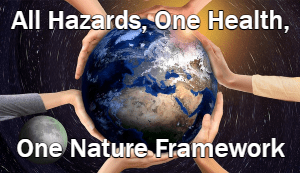All Hazards, One Health, One Nature Framework
Co-Authors: Allison A. Sakara, NP, MSN, RN, PHRN, and Maurice A. Ramirez, DO, PhD
“Look deep into nature, and then you will understand everything better.” – Albert Einstein
“New frameworks are like climbing a mountain, the larger view encompasses rather than rejects the more restricted view.” – Albert Einstein
Understanding and safeguarding the interconnectedness of our incredibly diverse planetary ecosystem is the foundation for the All Hazards, One Health, One Nature (AHOHN) Framework. From this unifying structure, goal-oriented and data-driven plans of action can be developed consistently and predictably, regardless of the nature of the hazard. The AHOHN Framework provides a shared template to meet the challenges of all hazards for the benefit of the entire One Nature, which includes the following outcomes:
- Address all threats, from local to global
- Strengthen health security
- Mitigate health disparities
- Emphasize preventive health measures, animal welfare, and environmental protection
- Promote coordination across all stakeholders
- Develop and implement effective policies
- Ensure the health and well-being of all living things
The phrase “All Hazards, One Health, One Nature” is a call to acknowledge and appreciate the interdependence of all creatures and habitats. By protecting and preserving the animals and plants that surround us, we are protecting and preserving ourselves. The concept of AHOHN emphasizes the need to address the challenges of health, nature, and medicine in an integrated, wholistic manner. To that end, the AHOHN Framework combines the four concepts critical to global health security into one approach. This article aims to define each of these constructs – All Hazards, One Health, One Nature, and One Framework.
“All Hazards” is a term used to describe a broad range of potential threats or dangers that could have a significant disruptive impact. Such hazards include natural disasters, disease, accidents, terrorist attacks, and cyber threats. All Hazards emphasizes the need for comprehensive risk management and preparedness planning. Regardless of the underlying cause, the All Hazards paradigm advocates for a unified response to any disaster or emergency. The methods, practices, procedures, and protocols that create a pathway for action are the same. The “All Hazards” is a reminder that every hazardous situation – from floods, to droughts, to wildfires, to hurricanes, to terrorism, to disease, to crime – interrupts the normal. This results in immediate needs exceeding available resources.
“One Health” refers to an interdisciplinary approach to healthcare that focuses on the relationship that exists and connects all living things. This model aims to address the interdependence of human, animal, and environmental health to promote well-being for all. What impacts the health of one species will impact many species, positively or negatively, magnifying the consequences of practices and policies. Sometimes referred to as “One Medicine,” this concept also emphasizes the importance of understanding the links between humans, animals, and their environment to prevent, diagnose, and treat disease effectively.
“One Nature” is the idea that all living things are interconnected, part of a unified system, and that humans are an integral part of this ecosystem. The importance of understanding and protecting the environment is an essential component. To create a healthier world, we need to recognize the interconnectedness of all life on Earth and address any threat to that life. The One Nature approach acknowledges that the health of humans, animals, and the environment are inextricably linked and that the health of humans and animals depend upon the health of their shared environment. One Nature is based on the understanding that threats to human health, the health of animals, and the health of the environment need to be addressed through collaborative, interdisciplinary means. This model also appreciates that actions taken to improve the well-being of one link positively impacts the others. Humans, animals, and the environment must be considered together as One Nature to achieve optimal health outcomes.
“One Framework” represents a wholistic approach in which all components are considered in a single, integrated system to achieve the best possible outcomes. This model is designed to help identify, measure, and manage the impacts of a broad range of causes and effects. Guidance provided by One Framework includes all aspects of preparedness – reducing risks, decreasing exposure to hazards, preparing for disasters, and planning for contingencies. This structure also guides mitigation of impact, response to rapidly changing conditions, provision for evolving needs, and recovery in the aftermath of adversity. The “One Framework” model recognizes that all hazards require collaborative and coordinated efforts by responders, survivors, and bystanders, as well as policymakers, conservationists, and other stakeholders.
The AHOHN Framework, then, is the comprehensive approach born of the above four concepts centered around the interconnected health and security of animals, plants, people, and habitats. As a result, the impact of any hazard – or any hazard mitigation – is recognized as having an impact on the whole of nature. Understanding these elements of the AHOHN Framework sets the stage for developing strategies to protect health and to meet the needs not just of ourselves but of all living things. And in the articles to follow in this series, we will explore real-world applications of the AHOHN Framework.
About the Authors:
Allison A. Sakara, NP, MSN, RN, PHRN, is a nurse practitioner with decades of experience in pediatrics, hematology/oncology, regulatory affairs, and disaster response. Allison is the Co-Founder & Executive Director of the High Alert Institute.
Maurice A. Ramirez, DO, PhD is a physician and innovator with over a quarter century of service in emergency medicine, consulting, computing, regulatory affairs, and disaster response. Dr. Ramirez is the recipient of the Lifetime Achievement Award in Disaster Medicine and Co-Founder of the High Alert Institute.
The High Alert Institute is a 501c3 not-for-profit educational public charity dedicated to providing disaster readiness education and resources to unserved and underserved communities, industries, and charitable organizations in an All Hazards, One Health, One Nature Framework. Learn more about the High Alert Institute at www.HighAlertInstitute.org










